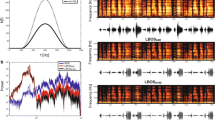Abstract
In sensory physiology, various System Identification methods are implemented to formalized stimulus-response relationships. We applied the Volterra approach for characterizing input-output relationships of cells in the medial geniculate body (MGB) of an awake squirrel monkey. Intraspecific communication calls comprised the inputs and the corresponding cellular evoked responses—the outputs. A set of vocalization was used to calculate the kernels of the transformation, and these kernels subserved to predict the responses of the cell to a different set of vocalizations. It was found that it is possible to predict the response (PSTH) of MGB cells to natural vocalizations, based on envelopes of the spectral components of the vocalization. Some of the responses could be predicted by assuming a linear transformation function, whereas other responses could be predicted by non-linear (second order) kernels. These two modes of transformation, which are also reflected by a distinct spatial distribution of the linearvis-à-vis non-linear responding cells, apparently representa new revelation of parallel processing of auditory information.
Similar content being viewed by others
Literature
Aitkin, L. M. 1973. “Medial Geniculate Body of Cat: Responses to Tonal Stimuli of Neurons in Medial Division.”J. Neurophysiol. 36, 275–283.
Allon, N. and Y. Yeshurun. 1985. “Functional Organization of the MGB Subdivisions of the Awake Squirrel Monkey.”Brain Res. 360, 75–82.
— and Z. Wollberg. 1981. “Reponses of Single Cells in the MGB of Awake Squirrel Monkeys.”Exp. Brain Res. 41, 222–232.
Capranica, R. R. 1972. “Why Auditory Neurophysiologists Should be more Interested in Animal Sound Communication.”Physiologist 1, 55–60.
Eggermont, J. J., A. M. H. J. Aertzern and P. I. M. Johannesma. 1983. “Prediction of Responses of Auditory Neurons in the Midbrain of the Grass Frog Based on the Spectro-Temporal Receptive Field.”Hearing Res. 10, 191–202.
Evans, E. F. 1974. Neural Processes for the Detection of Acoustic Patterns and for Sound Localization, the Neurosciences 3rd Study Program, pp. 131–145. Boston: MIT Press.
—, 1977. “Peripheral Processing of Complex Sounds.”Dahlem workshop on recognition of complex acoustic signal, T. H. Bullock (Ed.), pp. 145–159. Berlin: Springer.
Fitzpatrick, K. A. and T. J. Imig. 1982. “Organization of Auditory Connections.”Cortical Sensory Organization, C. L. Woolsey (Ed.), pp. 71–109. New York: Humana Press.
Goldstein, J. L. 1967. “Auditory Nonlinearities.”J. Acoust. Soc. Am. 41, 676–679.
Hung, G. and L. Stark. 1977. “The Kernel Identification Method—Review of Theory, Calculation, Application and Interpretation.”Math. Biosci 37, 135–140.
Imig, T. J. and A. Morel. 1983. “Organization of the Thalamocortical Auditory System in the Cat.”Ann. Rev. Neurosci. 6, 95–101.
Jordan, H. 1973. “The Structure of MGB: A Cyto and Myeloarchitectonic Study in the Squirrel Monkey.”J. Comp. Neurol. 148, 469–480.
Marmarelis, P. Z. and V. Z. Marmarelis. 1978.Anaysis of Physiological Systems—the White Noise Approach. New York: Plenum Press.
— and K. I. Naka. 1974. “Identification of Multi Input Systems.”IEEE Trans. Biomed. Engng. 21, 88–101.
Newman, J. D. and Z. Wollberg. 1973. “Multiple Coding of Species Specific Vocalizations in the Auditory Cortex of Squirrel Monkey.”Brain Res 54, 2187.
Pfeifer, R. R. and I. D. Kim. 1973.Basic Mechanisms in Hearing, A. R. Moller (Ed.). New York: Academic Press.
Ploog, D. 1981. “Neurophysiology of Primate Audio Vocal Behaviour.”Brain Res. Rev. 3, 35–61.
Suga, N. 1978. “Specialization of the Auditory System for Reception and Processing of Species Specific Sounds.”Fed. Proc. 37, 2341–2354.
—. 1982. “Functional Organization of the Auditory Cortex.”Cortical Sensory Organization, C. L. Woolsey (Ed.), pp. 157–214. New York: Humana Press.
Symmes, D., G. E. Alexander and J. D. Newman. 1980. “Neural Processing of Vocalizations and Artificial Stimuli in the MGB of Squirrel Monkey.”Hearing Res. 3, 135–146.
Watanabe, A. and L. Stark. 1975. “Kernel Method for Nonlinear Analysis: Identification of a Biological Control System.”Math. Biosci. 27, 99–108.
Wiener, N. 1958.Nonlinear Problems in Random Theory. New York: Wiley.
Winter, P., D. Ploog and Y. Latta. 1966. “Vocal Repertoire of the Squirrel Monkey, its Analysis and Significance.”Exp. Brain Res. 11, 359–384.
Yeshurun, Y., Z. Wollberg and N. Dyn. 1987. “Identification of MGB Cells by Volterra Kernels: Towards a Functional Classification of Cells.”Biol. Cybern 56, 203–208.
——— 1985. “Identification of MGB Cells by Volterra Kernels: Prediction of Responses to Species Specific Vocalization.”Biol. Cybern 51, 383–390.
Author information
Authors and Affiliations
Rights and permissions
About this article
Cite this article
Yeshurun, Y., Wollberg, Z. & Dyn, N. Prediction of linear and non-linear responses of MGB neurons by system identification methods. Bltn Mathcal Biology 51, 337–346 (1989). https://doi.org/10.1007/BF02460112
Received:
Revised:
Issue Date:
DOI: https://doi.org/10.1007/BF02460112




